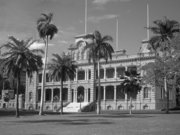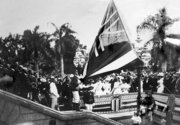Kingdom of Hawaii
|
|
The Kingdom of Hawai‘i was established in 1810 upon the unification of the smaller independent chiefdoms of O‘ahu, Maui, Moloka‘i, Lāna‘i and the Big Island of Hawai‘i through swift and bloody battles, led by a warrior chief who later would be immortalized as Kamehameha the Great. Kamehameha failed to secure a victory in Kaua‘i, his effort hampered by a storm. Eventually, Kaua‘i's chief swore allegiance to Kamehameha's rule. The unification ended the feudal society of the Hawaiian islands transforming it into a "modern", independent constitutional monarchy crafted in the tradition of European empires.
| Contents |
Government
Government in the Kingdom of Hawai‘i was transformed in phases, each phase created by the promulgation of the constitutions of 1840, 1852, 1864 and 1887. Each successive constitution can be seen as a decline in the power of the monarch in favor of popularly elected representative government. The head of state and head of government in the Kingdom of Hawai‘i was the monarch. He or she oversaw the Privy Council which was charged with administration. A royal cabinet, the Privy Council consisted of ministers in charge of departments much like that of the American system. These ministers also acted as the monarch's primary advisors.
The 1840 Constitution created a bicameral parliament in charge of legislation. The two houses of the legislature were the House of Representatives (directly elected by popular vote) and the House of Nobles (appointed by the monarch with the advice of the Cabinet). The same constitution created a judiciary, charged with overseeing the courts and interpretation of laws. The Supreme Court was led by the Chief Justice, appointed by the monarch with the advice of the Cabinet.
The islands of Hawai‘i were divided into smaller administrative divisions: Kaua‘i, O‘ahu, Maui, and Hawai‘i. Kaua‘i region included Ni‘ihau, while Maui region included Kaho‘olawe, Lāna‘i and Moloka‘i. Each administrative region was governed by a governor appointed by the monarch.
Kamehameha Dynasty
From 1810 to 1893, the Kingdom of Hawai‘i would be ruled by two major dynastic families, the Kamehameha Dynasty and the Kalākaua Dynasty. Five members of the Kamehameha family would lead the government as its king. Two of them were direct sons of Kamehameha the Great himself. They were Liholiho (Kamehameha II) and Kauikeaouli (Kamehameha III). For a period between Liholiho and Kauikeaouli's reigns, Kamehameha the Great's primary wife, Queen Ka‘ahumanu, would rule as Queen Regent and Kuhina Nui, or Prime Minister.
Dynastic rule by the Kamehameha family tragically ended in 1872 with the death of Lot (Kamehameha V). Upon his deathbed, he summoned Princess Bernice Pauahi Bishop to declare his intentions of making her heir to the throne. She was the last direct Kamehameha family member surviving. She refused the crown and throne in favor of a private life with her husband, Charles Reed Bishop. Lot died before naming an alternative heir.
- Kamehameha I, (1795-1819)
- Kamehameha II, Liholiho, (1819-1824)
- Kamehameha III, Kauikeaouli, (1825-1854)
- Kamehameha IV, Alexander Liholiho, (1854-1863)
- Kamehameha V, Lot Kapuāiwa, (1863-1872)
Elected monarchy
The refusal of Princess Bernice Pauahi Bishop to take the crown and throne as Queen of Hawai‘i forced the legislature of the Kingdom to declare an election to fill the royal vacancy. From 1872 to 1873, several distant relatives of the Kamehameha line were nominated. In a popular vote, William C. Lunalilo became Hawai‘i's first of two elected monarchs.
Kalākaua Dynasty
Like his predecessor, Lunalilo failed to name an heir to the throne. He died unexpectedly after less than a year as King of Hawai‘i. Once again, the legislature of the Kingdom of Hawai‘i was forced to declare an election to fill the royal vacancy. Queen Emma, widow of Kamehameha IV, was nominated along with David Kalākaua. The 1874 election was opined to be one of the nastiest political campaign seasons ever in Hawai‘i history. Both candidates resorted to mudslinging and rumors. David Kalākaua was elected the second elected King of Hawai‘i.
Hoping to avoid uncertainty in the monarchy's future, Kalākaua proclaimed several heirs to the throne and defined a royal line of succession. His sister Lili‘uokalani would succeed the throne upon Kalākaua's death. It was indicated that Princess Victoria Ka‘iulani would follow. If she could not produce an heir by birth, Prince Jonah Kūhiō Kalaniana‘ole would rule after her.
- David Kalākaua, (1874-1891)
- Lili‘uokalani, (1891-1893)
Overthrow of the Kingdom of Hawai'i
Queen Lili‘uokalani inherited a monarchy that was left impotent by her brother's Bayonet Constitution of 1887. David Kalākaua's Royal Cabinet forced him at gunpoint to sign the constitution stripping the monarchy of much of its power in favor of an administration controlled by Americans. The constitution was the opening salvo to the end of the Kingdom of Hawai‘i.
In 1893, American businessmen seeking to protect their industrial profits in the exportation of goods like sugar to the United States of America organized the overthrow of the Kingdom of Hawai‘i. American troops aboard the USS Boston landed in Honolulu to help Sanford B. Dole and Lorrin A. Thurston's Committee of Safety, a 13 member council of businessmen plotting to depose Queen Lili‘uokalani. At the gunpoint of American soldiers, Queen Lili‘uokalani was removed from ‘Iolani Palace under arrest, tried by the American Judge Advocate General's Corps and then imprisoned in her own home.
Dole and his committee declared itself the provisional government and proclaimed the creation of the Republic of Hawai‘i. Dole became its president. As a republic, it was the intention of the provisional government to campaign for annexation with the United States of America. With annexation, their goods and services exported to the mainland would not be subject to American tariffs. The provisional government succeeded when in 1897, Congress approved the Treaty of Annexation creating the U.S. Territory of Hawai‘i. Dole was appointed its first governor.
Royal estates
Early in its history, the Kingdom of Hawai‘i was governed from several locations including coastal towns on the islands of Hawai‘i and Maui (Lahaina). It wasn't until the reign of Kamehameha III that a capital was established in Honolulu on the Island of O‘ahu.
By the time Kamehameha V was king, he saw the need to build a royal palace fitting of the Kingdom of Hawai‘i's new found prosperity and standing with the royals of other nations. He commissioned the building of the palace at Ali‘iolani Hale. He died before it was completed. Today, the palace houses the Supreme Court of the State of Hawai‘i.
David Kalākaua shared the dream of Kamehameha V to build a palace for all the same reasons. He commissioned the construction of ‘Iolani Palace from which he and his successor would govern. In later years, the palace would become his sister's makeshift prison under guard by the U.S. Armed Forces, the site of the official raising of the U.S. flag during annexation, and then the site of the territorial governor's and legislature's offices.
Palaces
- ‘Āinahau, Home of Princess Victoria Ka‘iulani
- Ali‘iolani Hale, Originally designed as a Palace for Kamehameha V, although Kamehameha V later decided to convert the building into a government building during construction
- Hanaiakamalama, Summer Palace of Queen Emma
- Hulihe‘e Palace, Palace of Princess Ruth
- Keōua Hale, Palace of Princess Ruth
- ‘Iolani Palace, Palace of the Kalākaua Dynasty
Royal grounds
Other notable Hawaiian royals
Kawaiahao.jpg
Kamehameha Dynasty
- Bernice Pauahi Bishop, Princess of Hawai‘i
- Ka‘ahumanu, Queen Regent of Hawai‘i
- Kalama Hakaleleponi Kapakuhaili, Queen Consort of Hawai‘i
- Victoria Kamamalu, Queen Consort of Hawai‘i
- Ruth Ke‘elikōlani, Princess of Hawai‘i
- Keopuolani, Queen Consort of Hawai'i
- Kina‘u, Queen Regent of Hawai'i
- Emma Rooke, Queen Consort of Hawai'i
- Elizabeth Kekaaniau, Princess of Hawai'i
- Theresa Owana Kaohelelani, Princess of Hawai'i
Kalākaua Dynasty
- Victoria Ka‘iulani, Princess of Hawai‘i
- Jonah Kuhio Kalaniana‘ole, Prince of Hawai‘i
- Julia Kapi‘olani, Queen Consort of Hawai‘i
- Abigail Campbell Kawananakoa, Princess of Hawai‘i
- David Kawananakoa, Prince of Hawai‘i
- William Pitt Leileiohoku, Prince of Hawai‘i
- Miriam K. Likelike, Princess of Hawai‘i
Other notable royal subjects

Authors and artists
- Henri Berger, composer
- Robert Louis Stevenson, author
Civil leaders
- John Adams Kuakini, governor
- Charles Reed Bishop, businessman and philanthropist
- James Campbell, businessman and philanthropist
- Archibald Cleghorn, businessman and royal consort
- Sanford B. Dole, chief justice
- John Owen Dominis, governor and royal consort
- Gerrit P. Judd, royal advisor
- Kuini Liliha, governor
- Lorrin A. Thurston, lawyer and publisher
- Robert William Wilcox, soldier
- John Young, royal advisor
- Benjamin Dillingham, businessman and industrialist
Religious leaders
- Father Damien, Catholic missionary
- Louis Maigret, Catholic bishop
- Thomas Nettleship Staley, Anglican bishop
See also
- History of Hawai‘i
- Provisional Government of Hawai‘i
- Republic of Hawai‘i
- Territory of Hawai‘i
- State of Hawai‘i
References
- Lydia Lili‘uokalani Dominis, Hawai‘i's Story by Hawai‘i's Queen Lili‘uokalani (http://search.barnesandnoble.com/textbooks/booksearch/isbnInquiry.asp?userid=z0s1KLi1XP&isbn=0935180850&TXT=Y&itm=1), Mutual Publishing Co., 1994
- Michael Dougherty, To Steal a Kingdom: Probing Hawaiian History (http://search.barnesandnoble.com/textbooks/booksearch/isbnInquiry.asp?userid=z0s1KLi1XP&isbn=096334840X&TXT=Y&itm=3), Hawaiian Style Press, 1994
- Gerard Manley Hopkins, Hawai‘i: The Past, Present, and Future of Its Island Kingdom: An Historic Account of the Sandwich Islands of Polynesia (http://search.barnesandnoble.com/booksearch/isbnInquiry.asp?userid=z0s1KLi1XP&isbn=0710307810&itm=7), Kegan Paul International Ltd., 2003
- Ralph Simpsin Kuykendall, Hawai'i: A History, from Polynesian Kingdom to American State (http://search.barnesandnoble.com/booksearch/isbnInquiry.asp?userid=z0s1KLi1XP&isbn=0758160720&itm=36), Textbook Publishers, 2003
- Ralph Simpson Kuykendall, Hawaiian Kingdom: Foundation and Transformation, 1778-1854, Vol. 1 (http://search.barnesandnoble.com/booksearch/isbnInquiry.asp?userid=z0s1KLi1XP&isbn=087022431X&itm=16), University of Hawai‘i Press, 1995
- Ralph Simpson Kuykendall, Hawaiian Kingdom: Twenty Critical Years, 1854-1874, Vol. 2 (http://search.barnesandnoble.com/booksearch/isbnInquiry.asp?userid=z0s1KLi1XP&isbn=0870224328&itm=17), University of Hawai‘i Press, 1995
- Ralph Simpson Kuykendall, Hawaiian Kingdon Volume 3: 1874-1893, the Kalakaua Dynasty (http://search.barnesandnoble.com/booksearch/isbninquiry.asp?userid=z0s1KLi1XP&pwb=1&ean=9780870224331), University of Hawai‘i Press, 1995
- Aldyth Morris, Lili‘uokalani (http://search.barnesandnoble.com/booksearch/isbnInquiry.asp?userid=z0s1KLi1XP&isbn=0824815432&itm=4), University of Hawai‘i Press, 1995
- Juri Mykkanen, Inventing Politics: A New Political Anthropology of the Hawaiian Kingdom (http://search.barnesandnoble.com/booksearch/isbnInquiry.asp?userid=z0s1KLi1XP&isbn=082481486X&itm=5), University of Hawai‘i Press, 2003
- Niklaus R. Schweizer, His Hawaiian Excellency: The Overthrow of the Hawaiian Monarchy and the Annexation of Hawai‘i (http://search.barnesandnoble.com/booksearch/isbnInquiry.asp?userid=z0s1KLi1XP&isbn=0820425877&itm=13), Lang, Peter Publishing, Inc., 1994
External links
- Overthrow of the Monarchy (http://www.hawaii-nation.org/soa.html), Article by Pat Pitzer, Spirit of Aloha, May 1994
- Hawaiian Kingdom Government (http://www.hawaiiankingdom.org/)pl:Królestwo_Hawajskie




